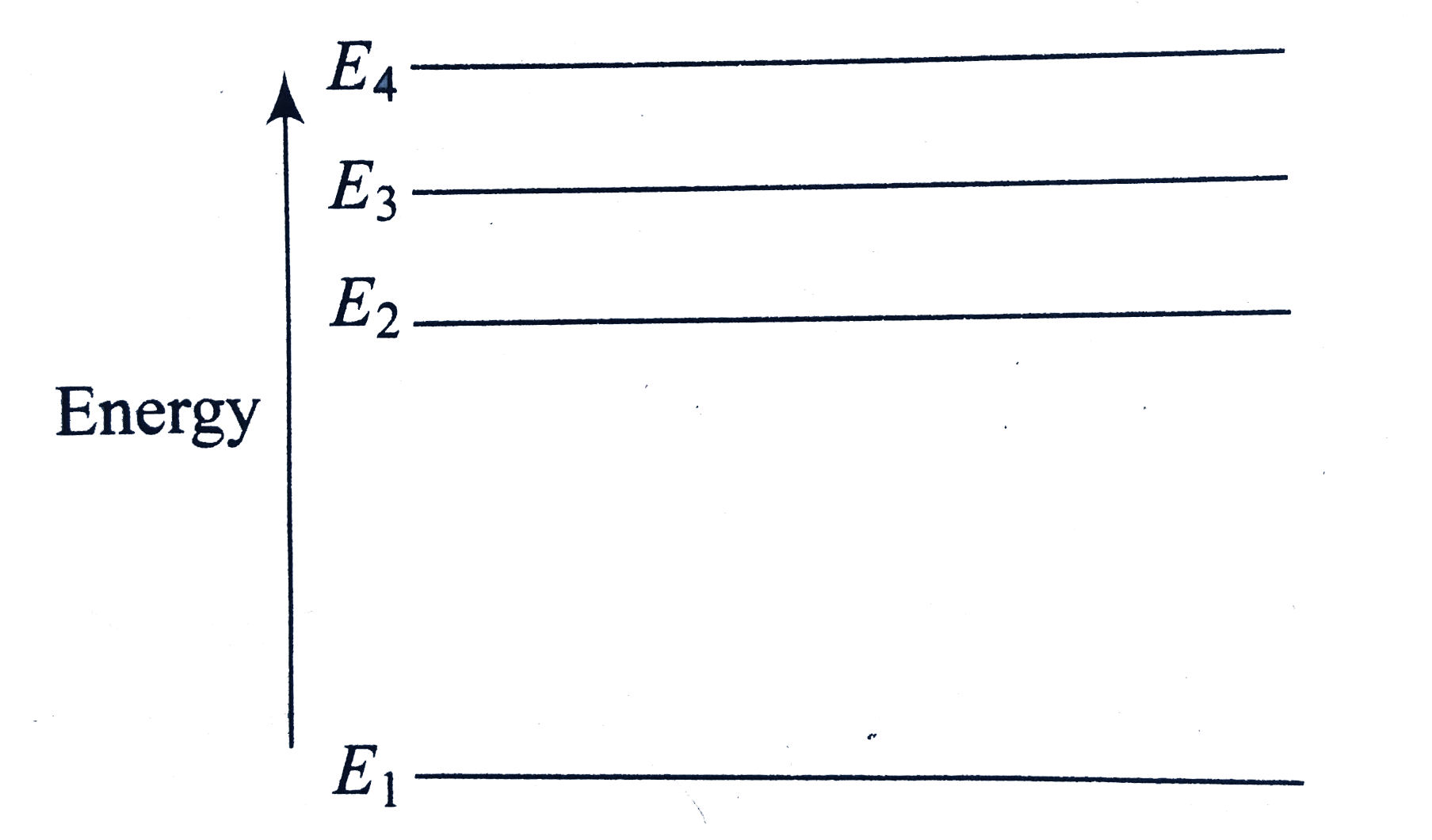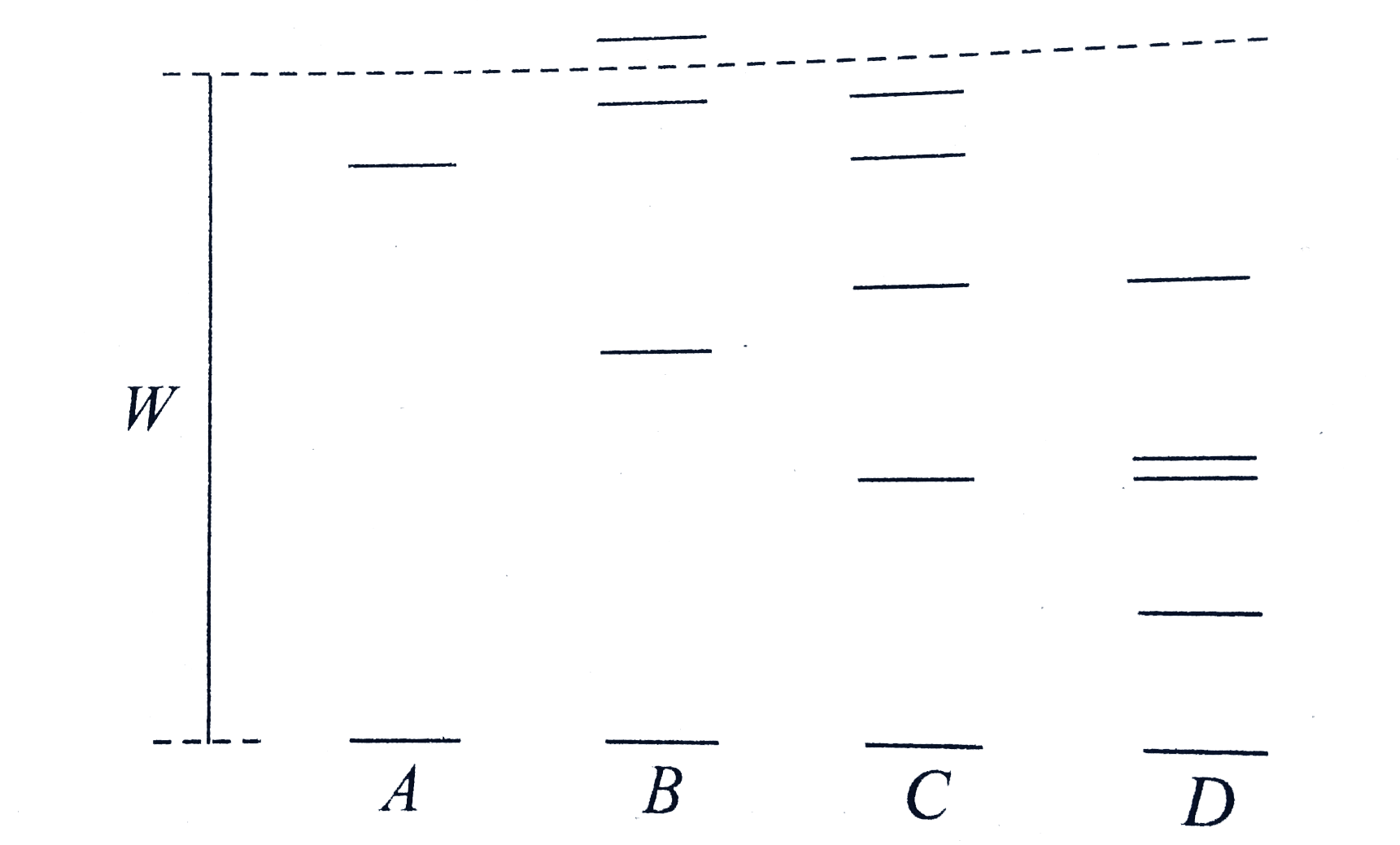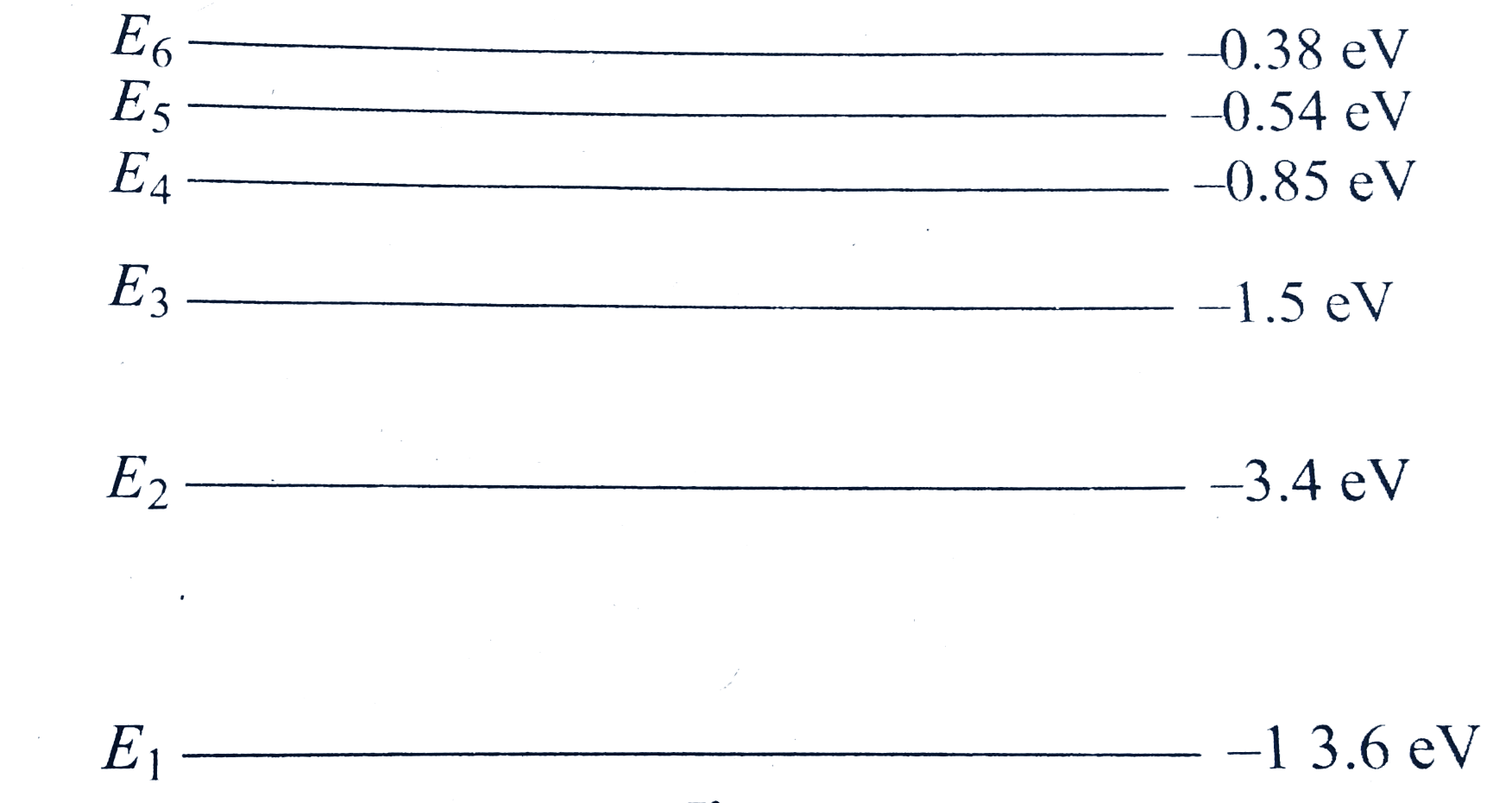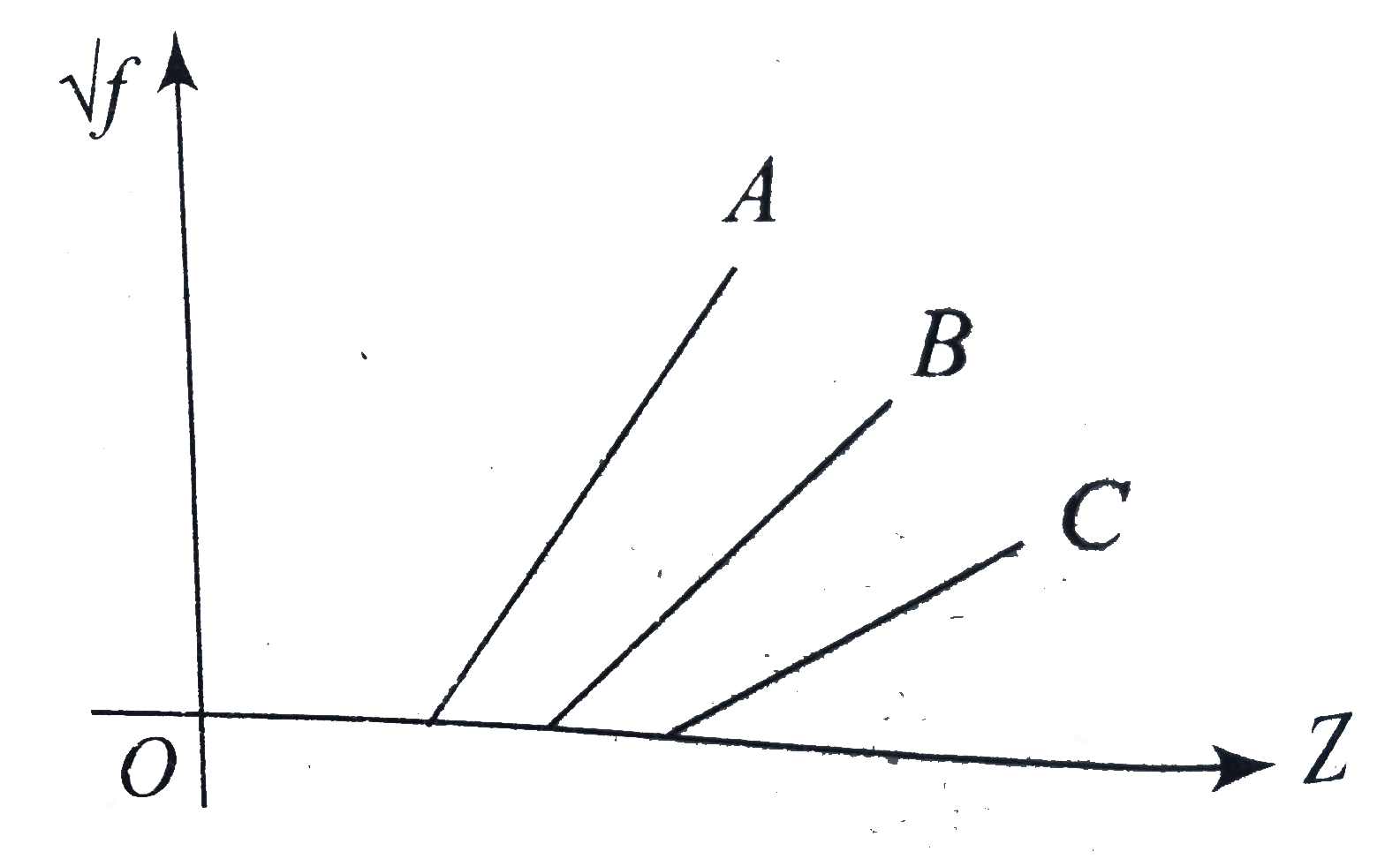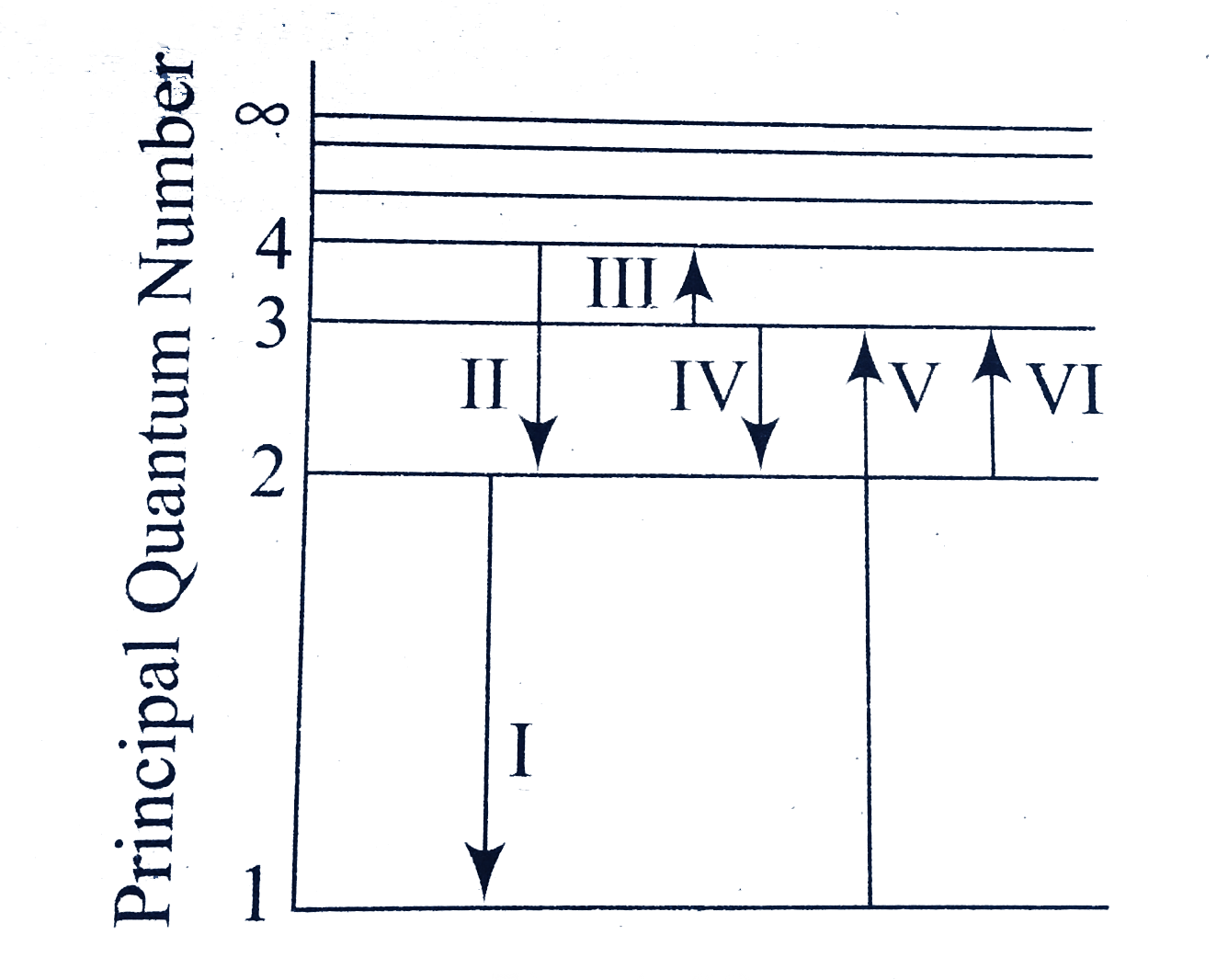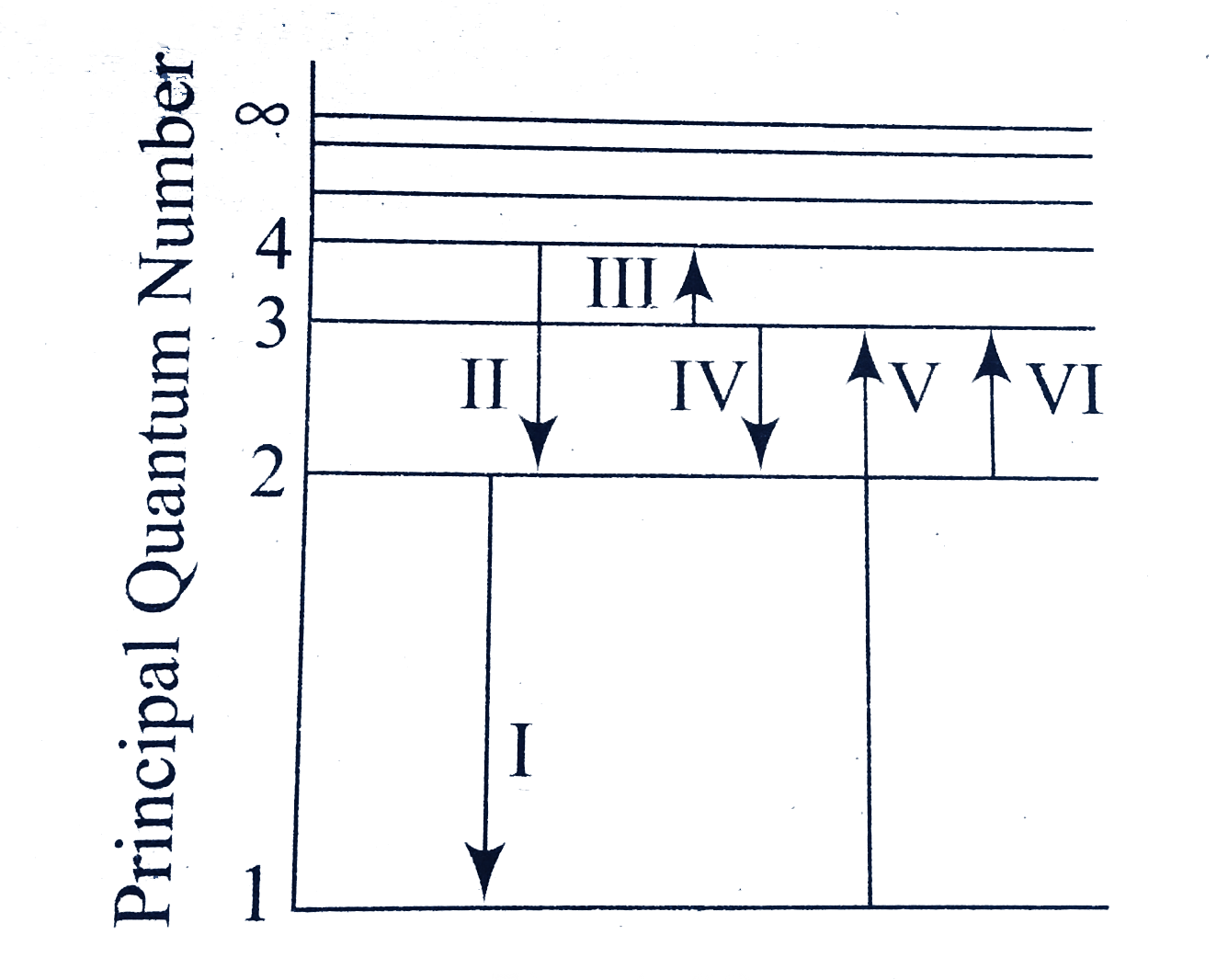Exercise 4.1 from CENGAGE PHYSICS (HINGLISH) ATOMIC PHYSICS for Class 12
| Class 12 | PHYSICS |
| Chapter | ATOMIC PHYSICS |
| CENGAGE PHYSICS (HINGLISH) | Exercise 4.1 |
| Medium | English |
| Academic Year | 2023-2024 |
Question 1
State the Following statement as statements as TRUE and FALSE.
a. The redius of nth Bohr is proporitional to n2.
b. The total energy of electron in the nth orbit is inversely proporitional to n2.
c. The time period revolution of electron in the nth orbit is directly proporitional to n2.
d. The kinetic energy of electron is double of its potential energy with a negative sign.
e. Velocity of electron in an atom is independent of its mass.
f. Only balmer series of hydrogen atom lines in the visible range.
g. The angular momentum of an electron revolving in the first orbit of hydrogen is equal to that in first orbit of helium.
h. The binding energy of decuterium atom is more than that of hydrogen atom.
i Lyman series of hydrogen atom lines in the infrared region.View SolutionQuestion 8
An imaginary particle has a charge equal to that of an electron and mass 100 times the mass of the electron. It moves in a circular orbit around a nucleus of charge + 4e. Take the mass of the nucleus to be infinite. Assuming that the Bohr model is applicable to this system. (a)Derive an expression for the radius of nth Bohr orbit. (b) Find the wavelength of the radiation emitted when the particle jumps from fourth orbit to the second orbit.View SolutionQuestion 9
Hydrogen gas in the atomic state is excited to an energy level such that the electrostatic potential energy of H-atom becomes −1.7eV. Now, a photoelectric plate having work function w=2.3 eV is exposed to the emission spectra of this gas. Assuming all the transitions to be possible, find the minimum de-Broglie wavelength of the ejected photoelectrons.View SolutionQuestion 10
Taking into account the motion of the nucleus of a hydrogen atom , find the expressions for the electron's binding energy in the ground state and for the Rydberg constant. How much (in percent) do the binding energy and the Rydberg constant , obtained without taking into account corresponding values of these of these quantities?View SolutionQuestion 11
An electron having energy 20eV collides with a hydrogen atom in the ground state. As a result of the colllision , the atom is excite to a higher energy state and the electron is scattered with reduced velocity. The atom subsequentily returns to its ground state with emission of rediation of wavelength 1.216×10−7m. Find the velocity of the scattered electron. View SolutionQuestion 12
According to classical physics, an electron in periodic motion with emit electromagnetic radiation with the same frequency as that of its revolution. Compute this value for hydrogen atom in nth quantum theory permit emission of such photons due to transition between adjoining orbits ? Discuss the result obtained.View SolutionQuestion 15
Suppose that means were available for stripping 28 electrons from _29Cu in vapour of this metel.
a. Compute the first three energy level for the remaining electron.
b. Find the wavelength of the spectral line of the series for which n1=1,n1,3,4. What is the ionization potential for the last electron? View SolutionQuestion 16
a. X-ray are electromagnetic waves because these are producted by the deceleration of fast moving electron .
b. X-ray are electromagnetic waves because these produce line spectrum.
c. the cut-off wavelength depends on the target metarial .
d. The intensity of Kα transition is more probable then of Kβ
e The transition.
e. Frequency of Kα radiation is more than that of Kβ. View SolutionQuestion 21
(a) An X-ray tube produces a continuous spectrum of radiation with its shorts wavelength end ate0.45Å. What is the maximum energy of the photon in the radiation? (b) From your answer to (a) , guess what order of accelerating voltage (for electrons) is required in such a tube?View SolutionQuestion 28
The peak emission from a black body at a certain temprature occurs at a wavelength of 9000Å. On increase its temperature , the total radiation emmited is increased its 81 times. At the intial temperature when the peak radiation from the black body is incident on a metal surface , it does not cause any photoemission from the surface . After the increase of temperature, the peak from the black body caused photoemission. To bring these photoelectrons to rest , a potential equivalent to the excitation energy between n=2andn=3 bohr levels of hydrogen atoms is required. Find the work function of the metal.View SolutionQuestion 29
In a hydrogen-like atom , an electron is orbating in an orbit having quantum number n. Its frequency of revolution is found to be 13.2×1015 Hz. Energy required to move this electron from the atom to the above orbit is 54.4eV. In a time of ? nano second the electron jumps back to orbit having quantum numbern/2.If τ be the average torque acted on the electron during the above process, then find τ×1027 in Nm. (given: h/λ=2.1×10−34J−s, friquency of revolution of electron in the ground state of H atom v0=6.6×1015 and ionization energy of H atom (E0=13.6eV)View SolutionQuestion 30
An electron is orbiting is a circular orbit of radius r under the influence of a constant magnetic field of strength B. Assuming that Bohr postulate regarding the quantization of angular momentum holds good for this electron, find
(a) the allowed values of te radius r of the orbit.
(b) the kinetic energy of the electron in orbit
(c ) the potential energy of interaction between the magnetic moment of the orbital current due to the electron moving in its orbit and the magnetic field B.
(d) the total energy of the allowed energy levels.
(e) the total magnetic flux due to the magnetic field B passing through the nth orbit. (Assume that the charge on the electron is -e and the mass of the electron is m). View SolutionQuestion 31
A hydrogen-like gas is kept in a chamber having a slit of width d=0.01mm. The atom of the gas are continuously excited to a certain energy state . The excite electron make transition to lower levels , From the initial excite state to the second excited state and then from the second excited state ground state. In the process of deexcitation, photons are emitted and come out of the container through a slit. The intensity of the photons is observed on a screen placed parallel to the plane of the slit . The ratio of the angular width of the central maximum corresponding to the two transition is 25/2. The angular width of the central maximum due to first transition is 6.4×10−2 radian. Find the atomic number of the gas and the principal quantum number of the inital excited state.View SolutionQuestion 33
A hydrogen atom (mass=1.66×10−27 kg "ionzation potential" = 13.6eV),mov∈gwhavelocity6.24 xx 10^(4) m s^(-1) makes a completely inelastic head-on collision with another stationary hydrogen atom. Both atoms are in the ground state before collision . Up to what state either one atom may be excited?View SolutionQuestion 34
Radiation from hydrogen gas excited to first excited state is used for illuminating certain photoelectric plate . When the radiation from same unknown hydrogen-like gas excited to the same level is used to expose the same plate , it is found that the de Broglie wavelength of the fastest photoelectron has decreased 2.3timegt It is given that the energy corresponding to the longest wavelength of the Lyman series of the known gas is 3 times the ionization energy of the hydrogen gas (13.6eV). Find the work function of photoelectric plate in eV. [Take(2.3)2=5.25] View SolutionQuestion 37
X-ray are emitted by a tube containing the electron gt Noibum (Z=41) as anticathode and the Kα X-ray an allowed to be incident on an unknown gas containing hydrogen- like atom ions. It is found that the X-ray cause the emission of photoelectrons with an energy of 2.7keV from these ions. Find
a. the minimum voltage at which the X-ray tube should be opreated so that the momentum of the emitted photoelectrons is doubled.
b. the approximate value of Z for the target of the anticathode after the momentum has been doubled.
c. the approximate value of Z the atomic number of the atom of the gas.
d. the number of the ion produced in the gas caused by X-ray , if the inetensity of X-ray is 100mWm−2 and 1% of the X-rays cause ionization. View SolutionQuestion 38
Electron of energies 10.20 eV and 12.09 eV can cause radiation to be emitted from hydrogen atoms . Calculate in each case, the principal quantum number of the orbit to which electron in the hydrogen atom is raised and the wavelength of the radiation emitted if it drops back to the ground state.View SolutionQuestion 41
A μ−meson("charge -e , mass = 207 m,wheremismassofe≤ctron) can be captured by a proton to form a hydrogen - like ''mesic'' atom. Calculate the radius of the first Bohr orbit , the binding energy and the wavelength of the line in the Lyman series for such an atom. The mass of the proton is 1836 times the mass of the electron. The radius of the first Bohr orbit and the binding energy of hydrogen are 0.529Å and 13.6eV , repectively. TakeR = 1.67 xx 109678 cm^(-1)View SolutionQuestion 42
A π−meason hydrogen atom is a bound state of negative charged pion (denoted by π¯,mπ=273me) and a proton. Estimate the number of revolutions a π−meason makes (averagely ) in the ground state on the atom before , it decays (mean life of a π−meason≅10−8s, mass of proton =1.67×10−27kg).View SolutionQuestion 44
A 100eV electron collides with a stationary helium ion (He+) in its ground state and excites to a higher level. After the collision , He+ ion emits two photons in succession with wavelength 1085Åand304Å. Find the principal quantum number of the excite in its ground state and. Also calculate energy of the electron after the collision. Given h=6.63×10−34Js. View SolutionQuestion 54
Figure shown five energy levels of an atom , one being much lower than the other four. Five transitios between the levels are idicated, each of which produces a photon of definite energy and frequency.
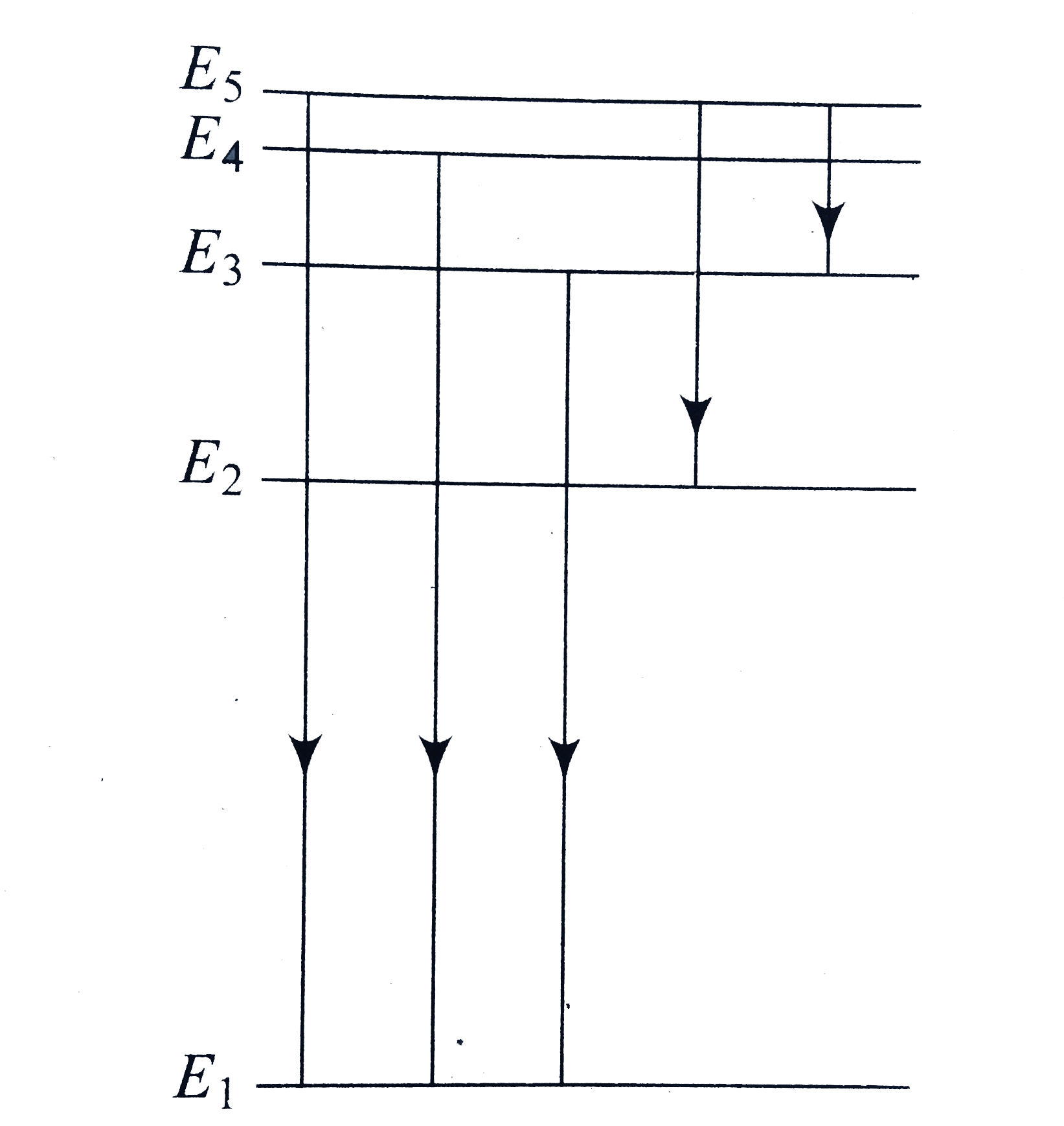 Which one of the spectrum below best corresponding to the set of transition indicated?View Solution
Which one of the spectrum below best corresponding to the set of transition indicated?View SolutionQuestion 59
Check the corretness of the following statement about the Bohr model of hydrogen atom:
(i) The acceleration of the electron in n=2 orbit is more than that in n=1 orbit.
(ii) The angular momentum of the electron in n=2 orbit is more than that in n=1 orbit.
(iii) The KE of the electron in n=2 orbit is more than that in n=1 orbit. View SolutionQuestion 63
Which of the following statement is true regarding Bohr's model of hydrogen atom ?
(I) Orbiting speed of electrons decreases as if falls to discrete orbits away from the nuclues.
(II) Radii of allowed orbits of electrons are proportional to the principle quantum number.
(III) Frequency with which electrons orbit around the nucleus in discrete orbits is inversely proportional to the principle quantum number.
(IV) Binding froce with which the elctron is bound to the nuclues increases as it shifts to outer orbits.
Selected the correct answer using the codes given below: View SolutionQuestion 64
In the Bohr model of a hydrogen atom, the centripetal force is furnished by the Coulomb attraction between the proton and the electrons. If a0 is the radius of the ground state orbit, m is the mass and e is the charge on the electron and e0 is the vacuum permittivity, the speed of the electron is View SolutionQuestion 103
The electron in a hydrogen atom make a transtion n1→n2 where n1andn2 are the priocipal quantum number of the two states . Assume the Bohr model to be valid . The time period of the electron in the initial state is eight time that in the final state . The possible values of n1andn2 are View SolutionQuestion 118
Imagine an atom made up of a proton and a hypothetical particle of double the mass of the electron but having the same charge as the electron . Apply the Bohr atom model and consider all possible transitions of this hypothetical particle that will be emitted level . The longest wavelength photon that will be emitted has longest wavelength λ (given in terms of the Rydberg constant R for the hydrogen atom) equal to View SolutionQuestion 122
The electron in a hydrogen atom make a transtion n1→n2 where n1andn2 are the priocipal quantum number of the two states . Assume the Bohr model to be valid . The time period of the electron in the initial state is eight time that in the final state . The possible values of n1andn2 are View SolutionQuestion 124
A photon collides with a stationary hydrogen atom in ground state inelastically. Energy of the colliding photon is 10.2 eV. After a time interval of the order of micro second another photon collides with same hydrogen atom inelastically with an energy of 15eV. What will be observed by the detector?View SolutionQuestion 133
Two hydrogen atoms are in excited state with electrons inn=2 state.First one is moving to wards left and emits a photon.' of energy E1 towards right. Second one is moving towards right with same speed and emits a photon of energy E2 towards right. Taking recoil of nucleus.into account during_emission process :View SolutionQuestion 146
A hydrogen like atom (atomic number Z) is in a higher excited state of quantum number n. The excited atom can make a transition to the first excited state by successively emitting two photons of energy 10.2 eV and 17.0 eV, respectively. Alternatively, the atom from the same excited state can make a transition to the second excited state by successively emitting two photons of energies 4.25 eV and 5.95 eV, respectively Determine the values of n and Z. (lonization energy of H-atom = 13.6 eV) View SolutionQuestion 148
A sample of hydrogen atom is in excited state (all the atoms ). The photons emitted from this sample are made to pass through a filter through which light having wavelength greater than 800nm can only pass. Only one type of photons are found to pass the filter. The sample's excited state initially is [Takehc=1240eV−nm, ground state energy of hydrogen atom =−13.6eV]. View SolutionQuestion 151
Electron in a hydrogen-like atom (Z=3) make transition from the forth excited state to the third excited state and from the third excited state to the second excited state. The resulting radiations are incident potential for photoelectrons ejested by shorter wavelength is 3.95eV.
Calculate the work function of the metal and stopping potiential for the photoelectrons ejected by the longer wavelength.View SolutionQuestion 166
In order to determine the value of E0, a scienctist shines photons (''light particles '')of various energies at a cloud of atomic hydrogen. Most of the hydrogen atom occupy transition through that cloud : see figure is a graph of part of the scientist's data, showing the idensity of the transmitted light as a function of the photon energy. A hydrogen atom's electron is likely to obsorb a photon only if the photon gives the electron enough energy to knock it into a higher shell.

According to this experiment , what is the approximate value of E0?View SolutionQuestion 183
When photon of wavelength λ1 are incident on an isolated shere supended by an insulated , the corresponding stopping potential is found to be V. When photon of wavelength λ2 are used , the orresponding stopping potential was thrice the above value. If light of wavelength λ3 is used , carculate the stopping potential for this case.View SolutionQuestion 205
X-ray emitted from a copper target and a molybdenum target are found to contains a line of wavelength 22.85nm attributed to the Kα line of an impurity element . The Kα line of copper (Z=29) and molybdenum (Z=42) have wavelength 15.42nmand7.12nm, respectively. The atomic number of the impurity element isView SolutionQuestion 207
In the Bohr model of a π−mesic atom , a π−mesic of mass mπ and of the same charge as the electron is in a circular orbit of ratio of radius r about the nucleus with an orbital angular momentum h/2π. If the radius of a nucleus of atomic number Z is given by R=1.6×10−15Z13m, then the limit on Z for which (ε0h2/πme2=0.53Åandmπ/me=264)π−mesic atoms might exist isView SolutionQuestion 211
Energy liberated in the de-excitation of hydrogen atom from the third level falls on a photo-cathode. Later when the same hoto-cathode is expoced to a spectrum of some unknown - like gas, excited to the second energy level , it is found that the de Broglie wavelength of the fastest photoelectrons now ejected has decreased by a factor of 3. For this new gas, difference of energies of the second Lyman line and the first balmer line is found to be 3 times the ionization potential of the hydrogen atom. Select the correct statement (s):View SolutionQuestion 229
Suppose frequency of emitted photon is f0 when the electron of a stationary hydrogen atom jumps from a higher state m to a lower state n. If the atom is moving with a velocity v(<<c) and emits a photon of frequency f during the same transition, then which of the following statement are possible?View SolutionQuestion 236
X-ray from a tube with a target A of atomic number Z shows strong K lines for target A and weakK lines for impurities. The wavelength og Kα lines is λz for target A and λ1andλ2 for two impurities.
λzλ1=4andλzλ2=14
Assuming the screeining contant of Kα lines to be unity select the correct statement(s).View SolutionQuestion 242
Statement I: In an X-ray tube , if the energy with which an electron strickes the metal target increases , then the wavelength of the characteristic X-rays also changes.
Statement II : Wavelength of the characteristic X-rays depends only on the initial and final energy levels.View SolutionQuestion 244
Hydrogen is the simplest atom of nature. There is one proton in its nucleus and an electron moves around the nucleus in a circular orbit. According to Niels Bohr's, this electron moves in a stationary orbit, if emits no electromagnetic radiation. The angular momentum of the electron is quantized , i.e., mvr=(nh/2π), where m= mass of the electron , v=velocity of the electron in the orbit , r=radius of the orbit , and n=1,2,3.... When transition takes place from Kth orbit to Jth orbit, energy photon is emitted. If the wavelength of the emitted photon is λ.
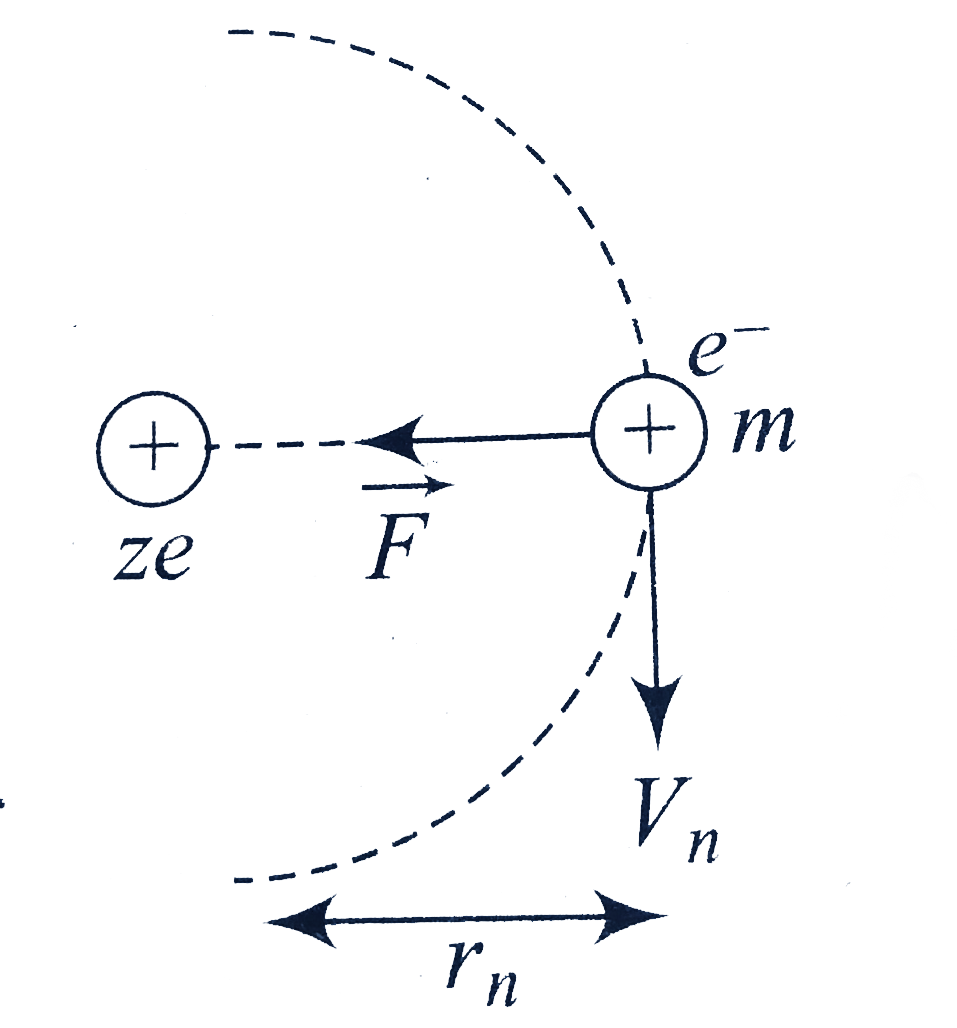
we find that 1λ=R[1J2−1K2], where R is
Rydberg's constant.
On a different planed, the hydrogen atom's structure was somewhat different from ours. The angular momentum of electron was P=2n(h/2π). i.e., an even multipal of (h/2π).
Answer the following questions regarding the other planet based on above passage:
The minimum permissible radius of the orbit will beView SolutionQuestion 245
Hydrogen is the simplest atom of nature. There is one proton in its nucleus and an electron moves around the nucleus in a circular orbit. According to Niels Bohr's, this electron moves in a stationary orbit, if emits no electromagnetic radiation. The angular momentum of the electron is quantized , i.e., mvr=(nh/2π), where m= mass of the electron , v=velocity of the electron in the orbit , r=radius of the orbit , and n=1,2,3.... When transition takes place from Kth orbit to Jth orbit, energy photon is emitted. If the wavelength of the emitted photon is λ.
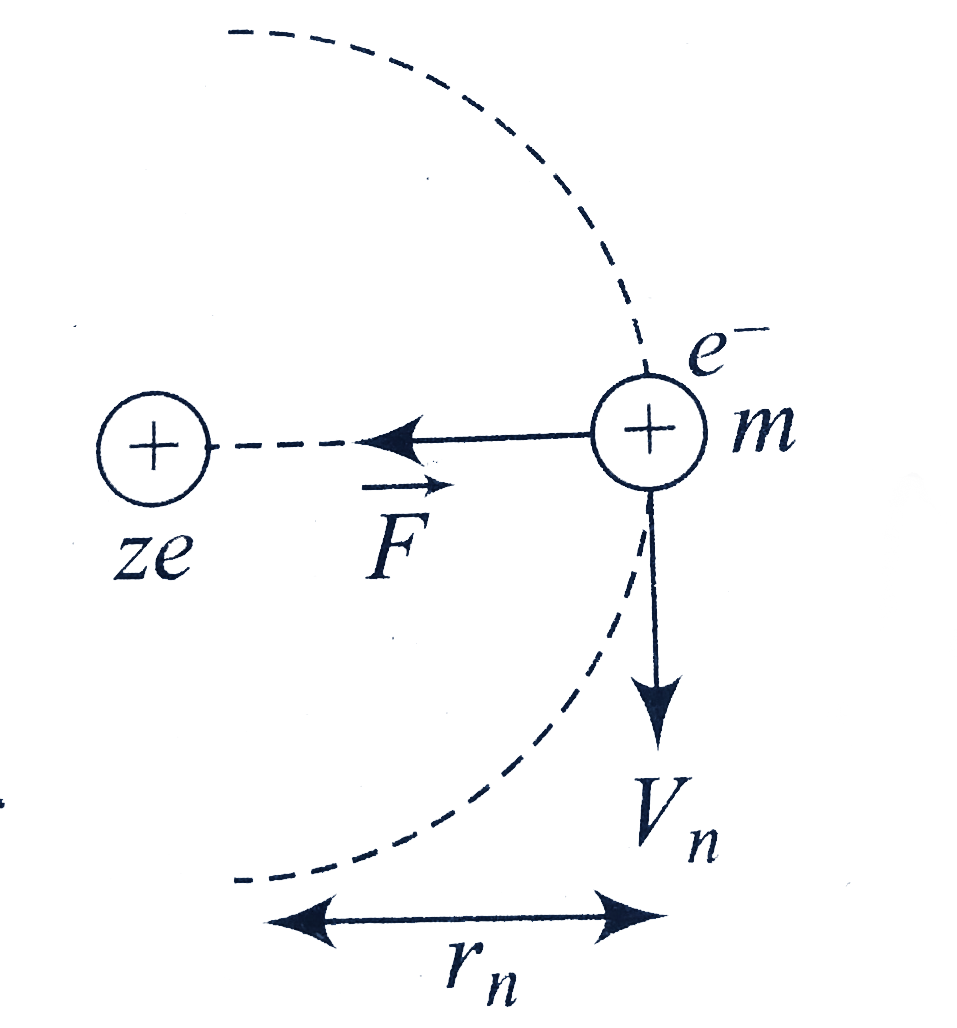
we find that 1λ=R[1J2−1K2], where R is
Rydberg's constant.
On a different planed, the hydrogen atom's structure was somewhat different from ours. The angular momentum of electron was P=2n(h/2π). i.e., an even multipal of (h/2π).
Answer the following questions regarding the other planet based on above passage:
In our world, the velocity of electron is v0 when the hydrogen atom is in the ground state on the other planet should beView SolutionQuestion 246
Hydrogen is the simplest atom of nature. There is one proton in its nucleus and an electron moves around the nucleus in a circular orbit. According to Niels Bohr's, this electron moves in a stationary orbit, if emits no electromagnetic radiation. The angular momentum of the electron is quantized , i.e., mvr=(nh/2π), where m= mass of the electron , v=velocity of the electron in the orbit , r=radius of the orbit , and n=1,2,3.... When transition takes place from Kth orbit to Jth orbit, energy photon is emitted. If the wavelength of the emitted photon is λ.
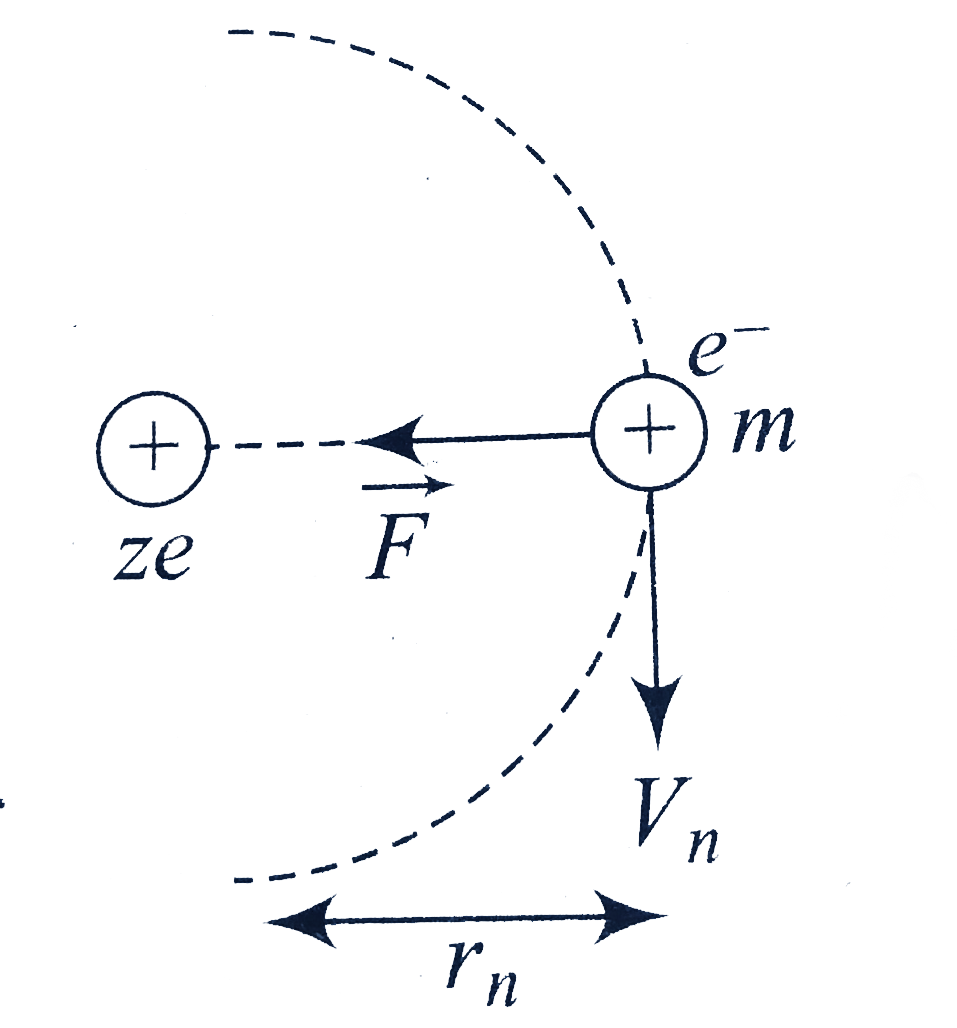
we find that 1λ=R[1J2−1K2], where R is
Rydberg's constant.
On a different planed, the hydrogen atom's structure was somewhat different from ours. The angular momentum of electron was P=2n(h/2π). i.e., an even multipal of (h/2π).
Answer the following questions regarding the other planet based on above passage:
In our world, the ionization potential energy of a hydrogen atom is 13.6eV. On the other planet, this ionization potential energy will beView SolutionQuestion 247
In an ordianary atom, as a first approximation, the motion of the nucleus can be ignored. In a positronium atom a positronreplaces the proton of hydrogen atom. The electron and positron masses are equal and , therefore , the motion of the positron cannot be ignored. One must consider the motion of both electron and positron about their center of mass. A detailed analyasis shows that formulae of Bohr's model apply to positronium atom provided that we replace me by what is known reduced mass is me/2.
The orbital radius of the first excited level of postronium atom isView SolutionQuestion 248
In an ordianary atom, as a first approximation, the motion of the nucleus can be ignored. In a positronium atom a positronreplaces the proton of hydrogen atom. The electron and positron masses are equal and , therefore , the motion of the positron cannot be ignored. One must consider the motion of both electron and positron about their center of mass. A detailed analyasis shows that formulae of Bohr's model apply to positronium atom provided that we replace me by what is known reduced mass is me/2.
If the Rydberg constant for hydrogen atom is R , then the Rydberg constant for positronium atom isView SolutionQuestion 249
In an ordianary atom, as a first approximation, the motion of the nucleus can be ignored. In a positronium atom a positronreplaces the proton of hydrogen atom. The electron and positron masses are equal and , therefore , the motion of the positron cannot be ignored. One must consider the motion of both electron and positron about their center of mass. A detailed analyasis shows that formulae of Bohr's model apply to positronium atom provided that we replace me by what is known reduced mass is me/2.
When system de-excites from its first excited state to ground state, the wavelngth of radiation isView SolutionQuestion 250
The electrons in a H- atom kept at rest , jumps from the mth shell to the nth shell (m>n). Suppose instead of emitting electromagnetic wave, the energy released is converted into kinetic energy of the atom. Assuming Bohr's model and conservation of angular momentum are valid. Now , answer the following questions:
What principal is violated of inertiaView SolutionQuestion 251
The electrons in a H- atom kept at rest , jumps from the mth shell to the nth shell (m>n). Suppose instead of emitting electromagnetic wave, the energy released is converted into kinetic energy of the atom. Assuming Bohr's model and conservation of angular momentum are valid. Now , answer the following questions:
Calculate the angular velocity of the atom about the nucleus if l is the momentum of inertiaView SolutionQuestion 252
The electrons in a H- atom kept at rest , jumps from the mth shell to the nth shell (m>n). Suppose instead of emitting electromagnetic wave, the energy released is converted into kinetic energy of the atom. Assuming Bohr's model and conservation of angular momentum are valid. Now , answer the following questions:
If the above comprehension be true , ehat is not valid here?View SolutionQuestion 260
The electron in a hydrogen atom at rest makes a transition from n=2 energy state to the n=1 ground state.
Assuming that all of the energy corresponding to transition from n=2→n=1 is carried off by the photon. By setting the momentum of the system (atom + photon) equal to zero after the emission and assuming that the recoil energy of the atom is smaller compared with the n=2→n=1 energy level separation , find the energy of the recoiling hydrogen atom.View SolutionQuestion 261
For a certain hypothetical one electron atom, the wavelength (∈Å) for the spectral lines for transitions originating at n=p and terminating at n=1 are given by λ=1500p2p2−1,wherep=2,3,4
(a)Find the wavelength of the least energetic and the most energetic photons in this series.
(b) Construct an energy level diagram for this element showing the energies of the lowest three levels.
(c ) What is the ionization potential of this element? View SolutionQuestion 262
For a certain hypothetical one electron atom, the wavelength (∈Å) for the spectral lines for transitions originating at n=p and terminating at n=1 are given by λ=1500p2p2−1,wherep=2,3,4
(a)Find the wavelength of the least energetic and the most energetic photons in this series.
(b) Construct an energy level diagram for this element showing the energies of the lowest three levels.
(c ) What is the ionization potential of this element? View SolutionQuestion 263
A sample of hydrogen gas in its ground state is irradiated with photons of 10.02eV energies. The radiation from the above sample is used to irradiate two other sample of excited ionized He+ and excited ionized Li2+, respectively. Both the ionized samples absorb the incident radiation.
How many spectral lines are obtained in the spectra of Li2+?View SolutionQuestion 264
A sample of hydrogen gas in its ground state is irradiated with photons of 10.02eV energies. The radiation from the above sample is used to irradiate two other sample of excited ionized He+ and excited ionized Li2+, respectively. Both the ionized samples absorb the incident radiation.
What is the smallest wavelength that will be observed in spectra of He+ ion ?View SolutionQuestion 265
A sample of hydrogen gas in its ground state is irradiated with photons of 10.02eV energies. The radiation from the above sample is used to irradiate two other sample of excited ionized He+ and excited ionized Li2+, respectively. Both the ionized samples absorb the incident radiation.
How many spectral lines are obtained in the spectra of He+ ion?View SolutionQuestion 266
A sample of hydrogen gas in its ground state is irradiated with photons of 10.02eV energies. The radiation from the above sample is used to irradiate two other sample of excited ionized He+ and excited ionized Li2+, respectively. Both the ionized samples absorb the incident radiation.
Which is the smallest wavelength that will be observed in spectra of Li2+ ?View SolutionQuestion 273
Pertain to the following statement and figure
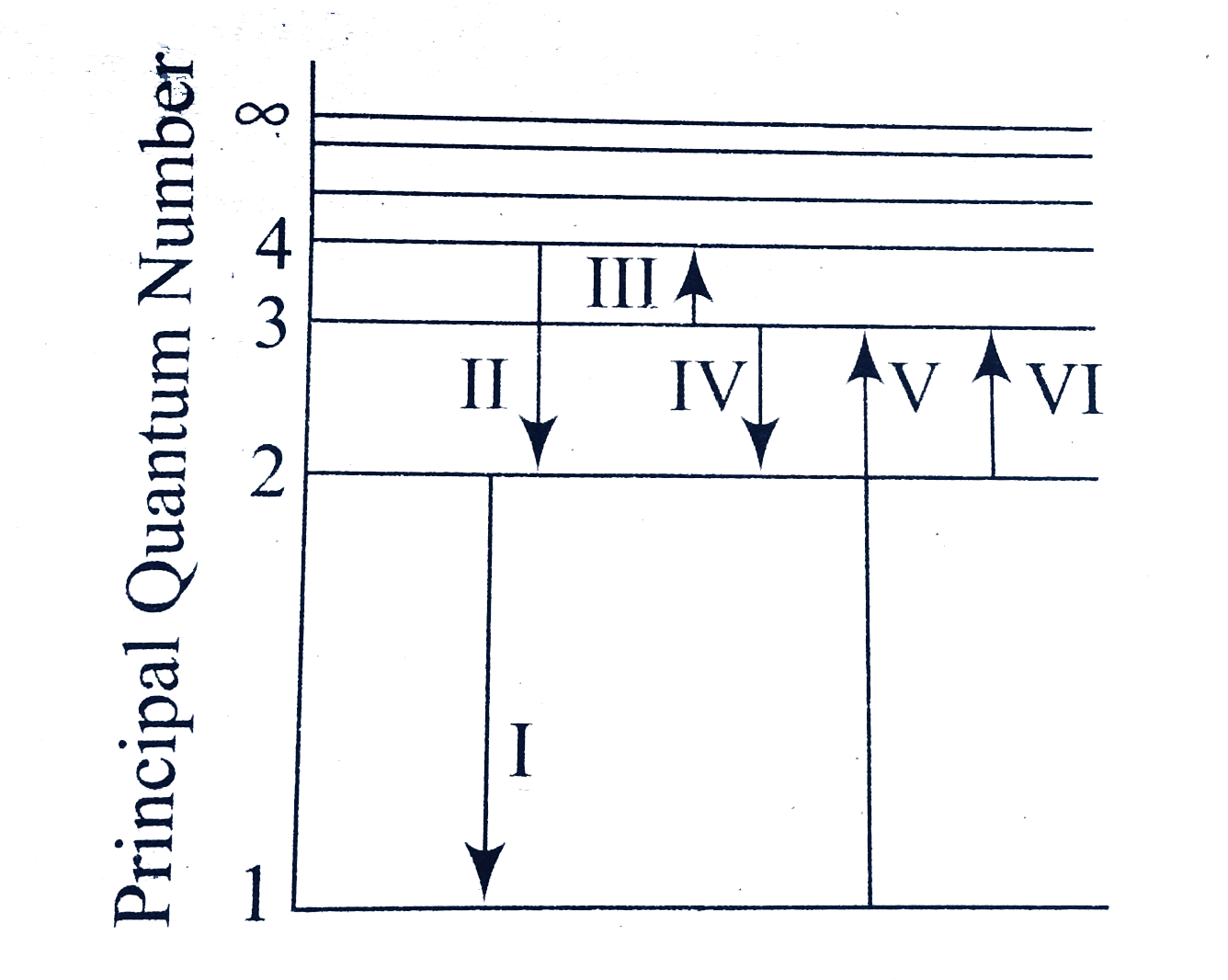
The figure above shown level diagram of the hydrogen atom. Serveral transition are market as I, II, III, … The diagram is only indicative and not to scale.
Which transition will occur when a hydrogen atom is irradiated with radiation of wavelength 103nm?View SolutionQuestion 274
A certain species of ionized atoms produces emission line spectral according to the Bohr's model. A group of lines in the spectrum is forming a series in which in the shortest wavelength is 22.79nm and the longest wavelength is 41.02nm. The atomic number of atom is Z.
Based on above information, answer the following question:
The value of Z isView SolutionQuestion 275
A certain species of ionized atoms produces emission line spectral according to the Bohr's model. A group of lines in the spectrum is forming a series in which in the shortest wavelength is 22.79nm and the longest wavelength is 41.02nm. The atomic number of atom is Z.
Based on above information, answer the following question:
The series belongs toView SolutionQuestion 276
A certain species of ionized atoms produces emission line spectral according to the Bohr's model. A group of lines in the spectrum is forming a series in which in the shortest wavelength is 22.79nm and the longest wavelength is 41.02nm. The atomic number of atom is Z.
Based on above information, answer the following question:
The nesxt to longest wavelength in the series of lines is View SolutionQuestion 277
Simplified model of electron energy levels for a cartain atom is shown in figure. The atom is bombarded will fast moving electrons. The impact of one of these electrons can cause the removal of electron from K-level , thus, creating a vacancy in the K-level. This vacancy in K-level is filled by an electron from l-level and the energy reased in this transition can either appear as electromagnetic waves or may all be used knock out an electron from M-level of the atom.
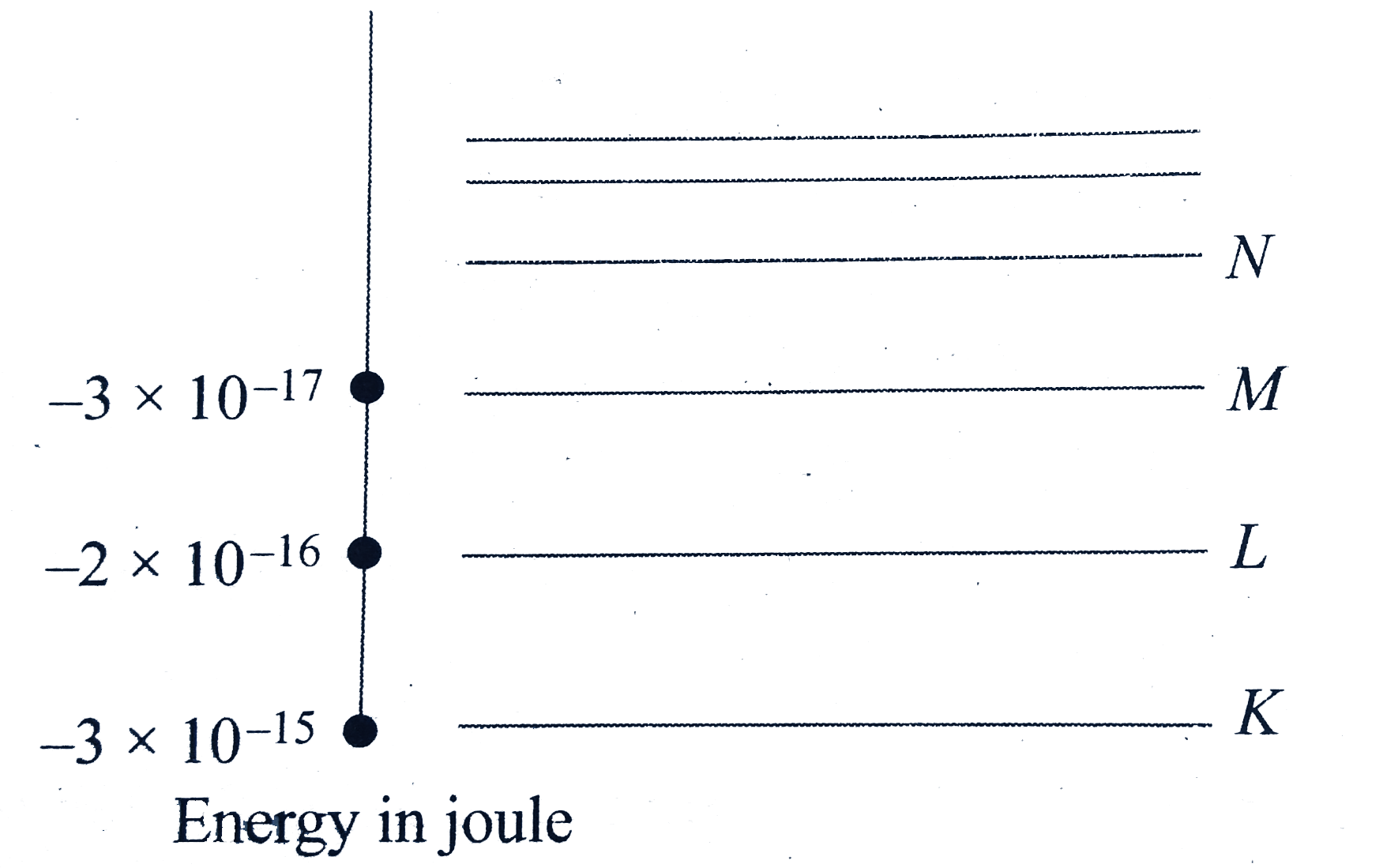
Based on above information, answer the following question:
The minimum potential difference through which bombarding electron beam must be acclerated from rest to cause the ejection of electron from K-level is.View SolutionQuestion 278
Simplified model of electron energy levels for a cartain atom is shown in figure. The atom is bombarded will fast moving electrons. The impact of one of these electrons can cause the removal of electron from K-level , thus, creating a vacancy in the K-level. This vacancy in K-level is filled by an electron from l-level and the energy reased in this transition can either appear as electromagnetic waves or may all be used knock out an electron from M-level of the atom.
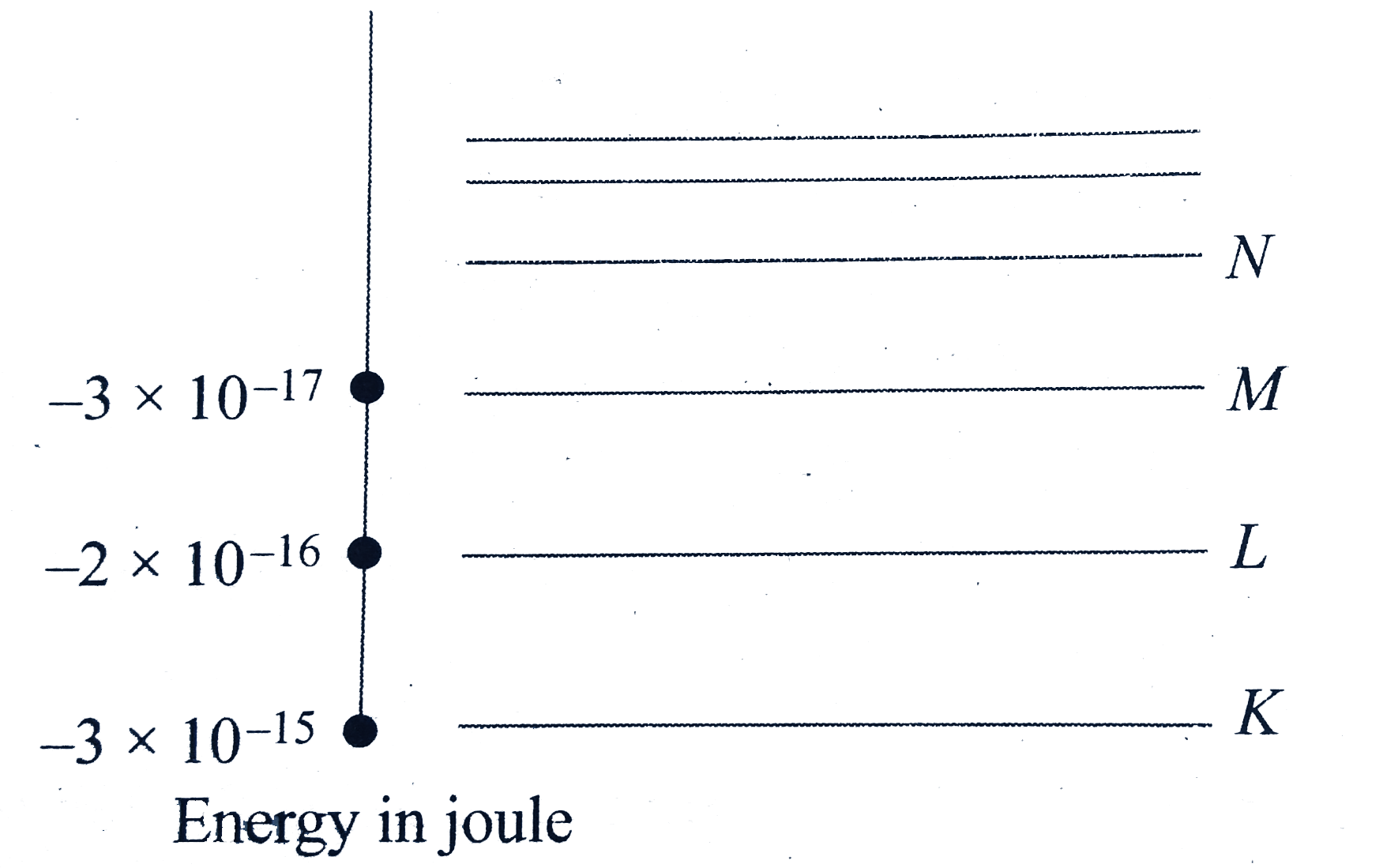
Based on above information, answer the following question:
Wavelength of the electromagnetic waves emitted due to transition from L to K-level isView SolutionQuestion 279
Simplified model of electron energy levels for a cartain atom is shown in figure. The atom is bombarded will fast moving electrons. The impact of one of these electrons can cause the removal of electron from K-level , thus, creating a vacancy in the K-level. This vacancy in K-level is filled by an electron from l-level and the energy reased in this transition can either appear as electromagnetic waves or may all be used knock out an electron from M-level of the atom.
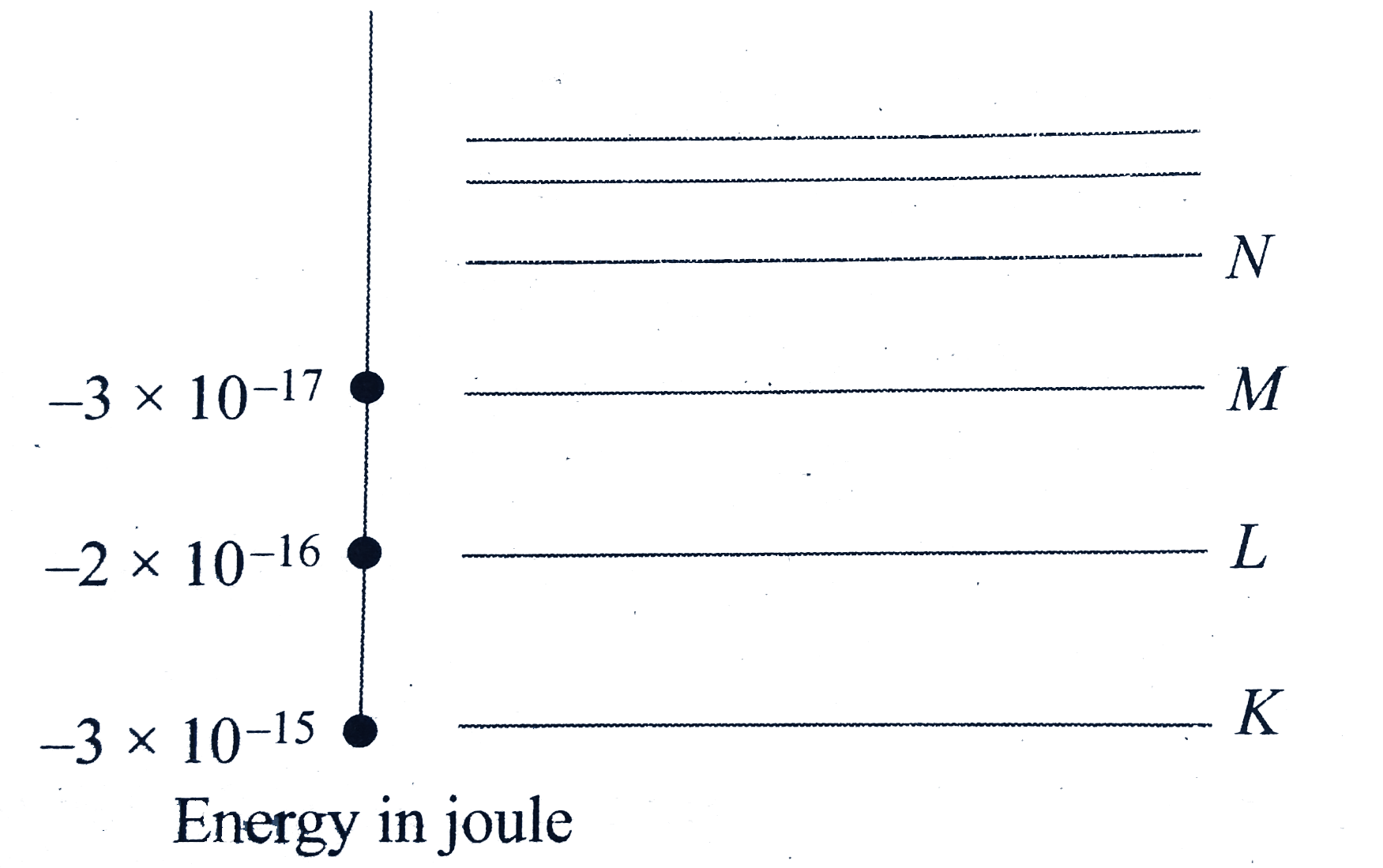
Based on above information, answer the following question:
The KE of the emitted electron from M-level isView SolutionQuestion 280
A monochromatic beam of light having photon energy 12.5eV is incident on a simple A of atomic hydrogen gas in which all almost are in the ground state. The emission spectra obtained from this sample is incident on another sample B of atomic hydrogen gas in which all atoms are in the first excited state.
Based on above information, answer the following question:
The atoms of sample A after passing of light through itView SolutionQuestion 281
A monochromatic beam of light having photon energy 12.5eV is incident on a simple A of atomic hydrogen gas in which all almost are in the ground state. The emission spectra obtained from this sample is incident on another sample B of atomic hydrogen gas in which all atoms are in the first excited state.
Based on above information, answer the following question:
The emission spectra of sample A View SolutionQuestion 282
A monochromatic beam of light having photon energy 12.5eV is incident on a simple A of atomic hydrogen gas in which all almost are in the ground state. The emission spectra obtained from this sample is incident on another sample B of atomic hydrogen gas in which all atoms are in the first excited state.
Based on above information, answer the following question:
The atoms of sample BView SolutionQuestion 283
A single electron orbits a stationary nucleus of charge +Ze, where Z is a constant and e is the magnitude of electronic charge . It requires 47.2eV to excite . Find
a the value of Z
b the energy required to excite the electron from the third to the fourth Bohr orbit.
the wavelength of electromagnetic rediation required to remove the electron from the first Bohr orbit to infinity.
d Find the KE,PE, and angular momentum of electron in the first Bohr orbit.
the redius of the first Bohr orbit
[The ionization energy of hydrogen atom =13.6eV Bohr radius =5.3×10_11m, "velocity of light" =3×10−8jms−1, Planck's constant =6.6×10−34j−s]View SolutionQuestion 284
A single electron orbits a stationary nucleus of charge +Ze, where Z is a constant and e is the magnitude of electronic charge . It requires 47.2eV to excite . Find
a the value of Z
b the energy required to excite the electron from the third to the fourth Bohr orbit.
the wavelength of electromagnetic rediation required to remove the electron from the first Bohr orbit to infinity.
d Find the KE,PE, and angular momentum of electron in the first Bohr orbit.
the redius of the first Bohr orbit
[The ionization energy of hydrogen atom =13.6eV Bohr radius =5.3×10_11m, "velocity of light" =3×10−8jms−1, Planck's constant =6.6×10−34j−s]View SolutionQuestion 285
A single electron orbits a stationary nucleus of charge +Ze, where Z is a constant and e is the magnitude of electronic charge . It requires 47.2eV to excite . Find
a the value of Z
b the energy required to excite the electron from the third to the fourth Bohr orbit.
the wavelength of electromagnetic rediation required to remove the electron from the first Bohr orbit to infinity.
d Find the KE,PE, and angular momentum of electron in the first Bohr orbit.
the redius of the first Bohr orbit
[The ionization energy of hydrogen atom =13.6eV Bohr radius =5.3×10_11m, "velocity of light" =3×10−8jms−1, Planck's constant =6.6×10−34j−s]View SolutionQuestion 286
When high energetic electron beam , (i.e., cathode rays) strike the heavier metal, then X-ray are produced. Spectrum of X-ray are classified into two categories: (i) continous spectrum, and (ii) characteristic depends only on the potential difference across the electrode. But wavelength of characteristic spectrum depends on the atomic number (z).
The production of characteristic X-ray is due to the View SolutionQuestion 287
When high energetic electron beam , (i.e., cathode rays) strike the heavier metal, then X-ray are produced. Spectrum of X-ray are classified into two categories: (i) continous spectrum, and (ii) characteristic depends only on the potential difference across the electrode. But wavelength of characteristic spectrum depends on the atomic number (z).
The production of continuous X-ray is due to the View SolutionQuestion 288
Light from a discharge tube containing hydrogen atoms falls on the surface of a piece of sodium . The kinetic energy of the fastest photoelectrons emitted from sodium is 0.73eV . The work function for sodium is 1.82eV find
(a) the energy of the photons causing the photoelectric emission ,
(b) the quantum number of the two level involved in the emission of these photons,
(c ) the change in the angular momentum of the electron in the hydrogen atom in the above transition and,
(d)the recoil speed of emitted atom assuming it to be at rest before the transition.
(lonization potential of hydrogen is 13.6eV) View SolutionQuestion 289
Light form a dicharge tube containing hydrogen atoms falls on the surface of a piece of sodium. The kinetic energy of the fastest photoelectrons emitted from sodium is 0.73 eV. The work function for sodium is 1.82 eV. Find (a) the energy of the photons causing the photoelectrons emission.
(b) the quantum numbers of the two levels involved in the emission of these photons.
(c ) the change in the angular momentum of the electron in the hydrogen atom, in the above transition, and
(d) the recoil speed of the emitting atom assuming it to be at rest before the transition. (lonization potential of hydrogen is 13.6 eV.) View SolutionQuestion 290
Light from a discharge tube containing hydrogen atoms falls on the surface of a piece of sodium . The kinetic energy of the fastest photoelectrons emitted from sodium is 0.73eV . The work function for sodium is 1.82eV find
(a) the energy of the photons causing the photoelectric emission ,
(b) the quantum number of the two level involved in the emission of these photons,
(c ) the change in the angular momentum of the electron in the hydrogen atom in the above transition and,
(d)the recoil speed of emitted atom assuming it to be at rest before the transition.
(lonization potential of hydrogen is 13.6eV) View SolutionQuestion 291
The electron in a Li++ ion is the nth shell , n being very large. One of the K-electron in another matallic atom has been knocked out. The second matel has four orbits. Now, we take two sample one of Li++ ion and the other of the second mateillic ions. Suppose the probability of electronic transition from higher to lower energy level is directly proportional to the energy difference between the two shells. Take hc=1224eVnm , where h is Planck's constant and c the velocity of light in vacuum. It is found that major electromagnetic wavws emitted from the two sample are identical. Now , answer the following questions:
What is the X-ray having least intensity emitted by the second sample?View SolutionQuestion 292
The electron in a Li++ ion is the nth shell , n being very large. One of the K-electron in another matallic atom has been knocked out. The second matel has four orbits. Now, we take two sample one of Li++ ion and the other of the second mateillic ions. Suppose the probability of electronic transition from higher to lower energy level is directly proportional to the energy difference between the two shells. Take hc=1224eVnm , where h is Planck's constant and c the velocity of light in vacuum. It is found that major electromagnetic wavws emitted from the two sample are identical. Now , answer the following questions:
What is the major X-ray emitted by the sample?View SolutionQuestion 293
The electron in a Li++ ion is the nth shell , n being very large. One of the K-electron in another matallic atom has been knocked out. The second matel has four orbits. Now, we take two sample one of Li++ ion and the other of the second mateillic ions. Suppose the probability of electronic transition from higher to lower energy level is directly proportional to the energy difference between the two shells. Take hc=1224eVnm , where h is Planck's constant and c the velocity of light in vacuum. It is found that major electromagnetic wavws emitted from the two sample are identical. Now , answer the following questions:
The wavelength of this major X-ray isView SolutionQuestion 294
Two hydrogen-like atoms A and B are of different masses and each atom contains equal numbers of protons and neutrons. The difference in the energies between the first Balmer lines emitted by AandB , is 5.667eV. When atom atoms AandB moving with the same velocity , strike a heavy target , they rebound with the same velocity in the process, atom B imparts twice the momentum to the target than that A imparts. Identify the atom AandB.View SolutionQuestion 295
Two hydrogen-like atoms A and B are of different masses and each atom contains equal numbers of protons and neutrons. The difference in the energies between the first Balmer lines emitted by AandB , is 5.667eV. When atom atoms AandB moving with the same velocity , strike a heavy target , they rebound with the same velocity in the process, atom B imparts twice the momentum to the target than that A imparts. Identify the atom AandB.View SolutionQuestion 296
1.8g of hydrogen is excite by irradiation. The study of spectra indicated that 27% of the atoms are in the first excite state, 15% of the aton in the second excited, and the rest in the ground state. The ground stat, ionization energy of hydrogen atom is 21.4×10−12ergs.
The number of atoms present in the second excited state isView SolutionQuestion 297
1.8g of hydrogen is excite by irradiation. The study of spectra indicated that 27% of the atoms are in the first excite state, 15% of the aton in the second excited, and the rest in the ground state. The ground stat, ionization energy of hydrogen atom is 21.4×10−12ergs.
The total amount of energy that would be evolved when all the atoms neutron to the ground state isView SolutionQuestion 298
In a set of experiment on a hydrogen on a hypothetical one-electron atom, the wavelength of the photons emitted from transition ending in the ground state (n=1) are shown in the energy level diagram
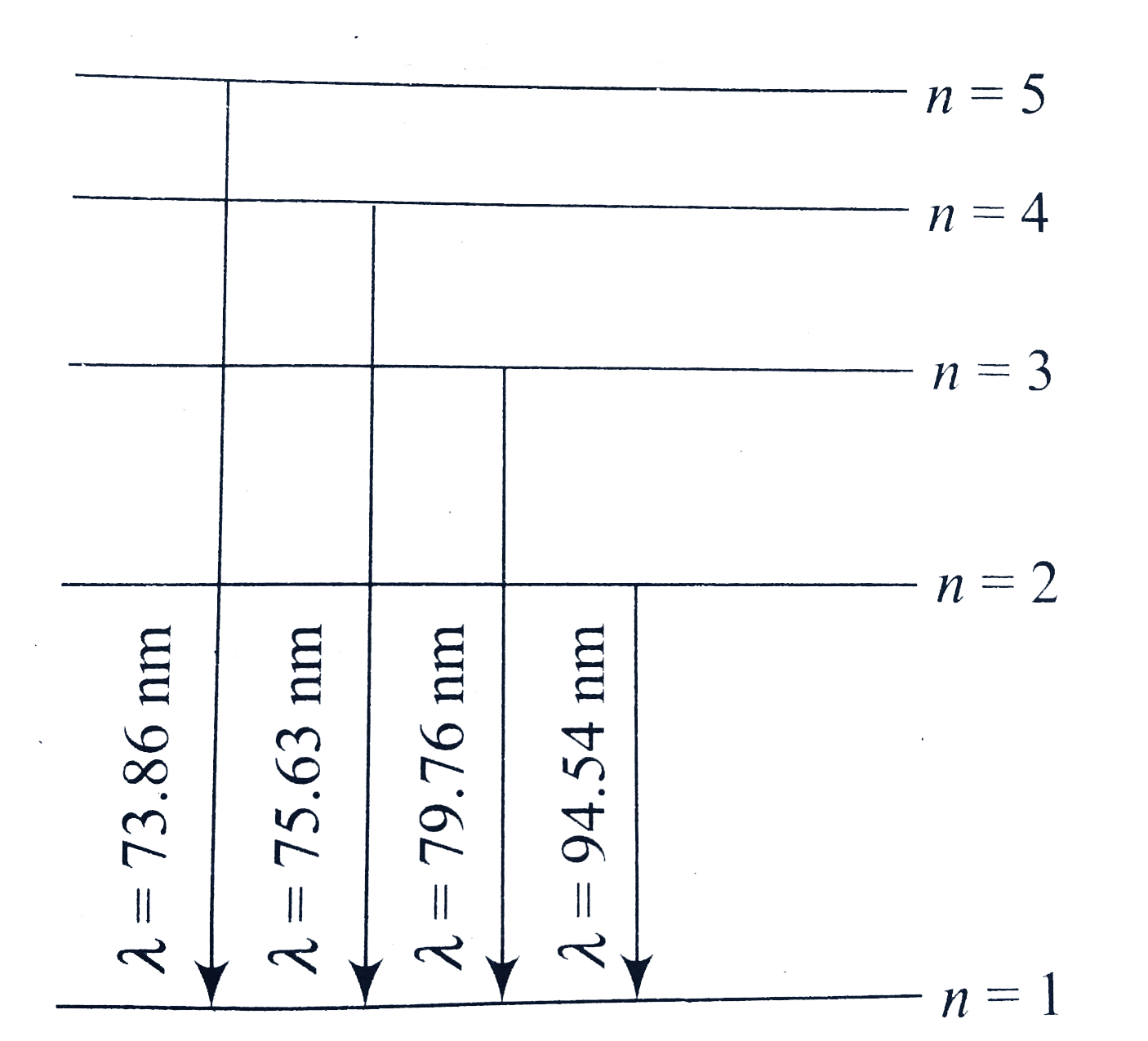
λ5→1=73.86nm
λ4→1=75.63nm
λ3→1=79.76nm
λ2→1=94.54nm
The energy of the atom in level n=1 is nearlyView SolutionQuestion 299
In a set of experiment on a hydrogen on a hypothetical one-electron atom, the wavelength of the photons emitted from transition ending in the ground state (n=1) are shown in the energy level diagram
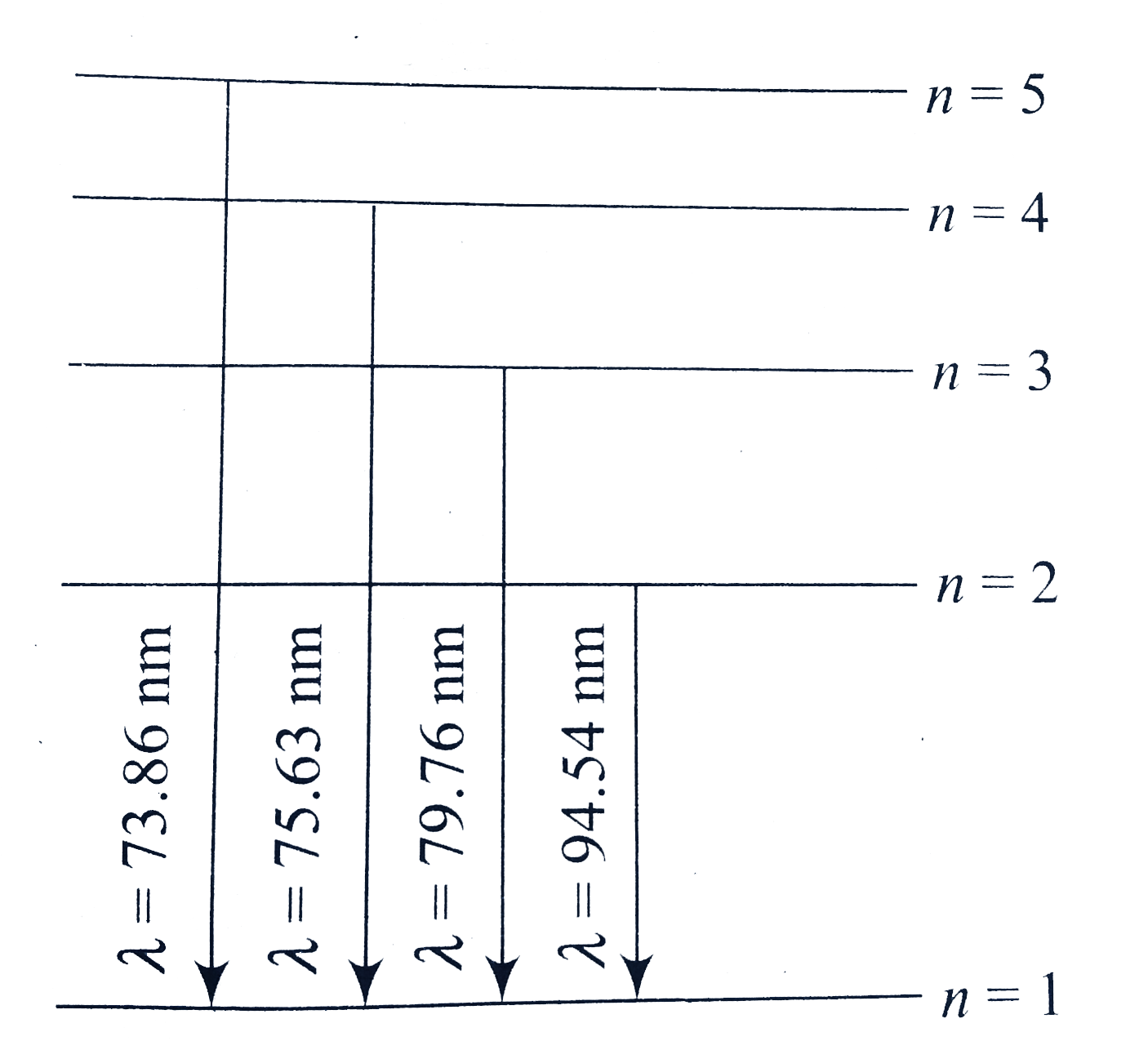
λ5→1=73.86nm
λ4→1=75.63nm
λ3→1=79.76nm
λ2→1=94.54nm
If an electron made a transition from n = 4 to n = 2 level, the wavelength of the light that it would emit is nearlyView SolutionQuestion 300
In a set of experiment on a hydrogen on a hypothetical one-electron atom, the wavelength of the photons emitted from transition ending in the ground state (n=1) are shown in the energy level diagram
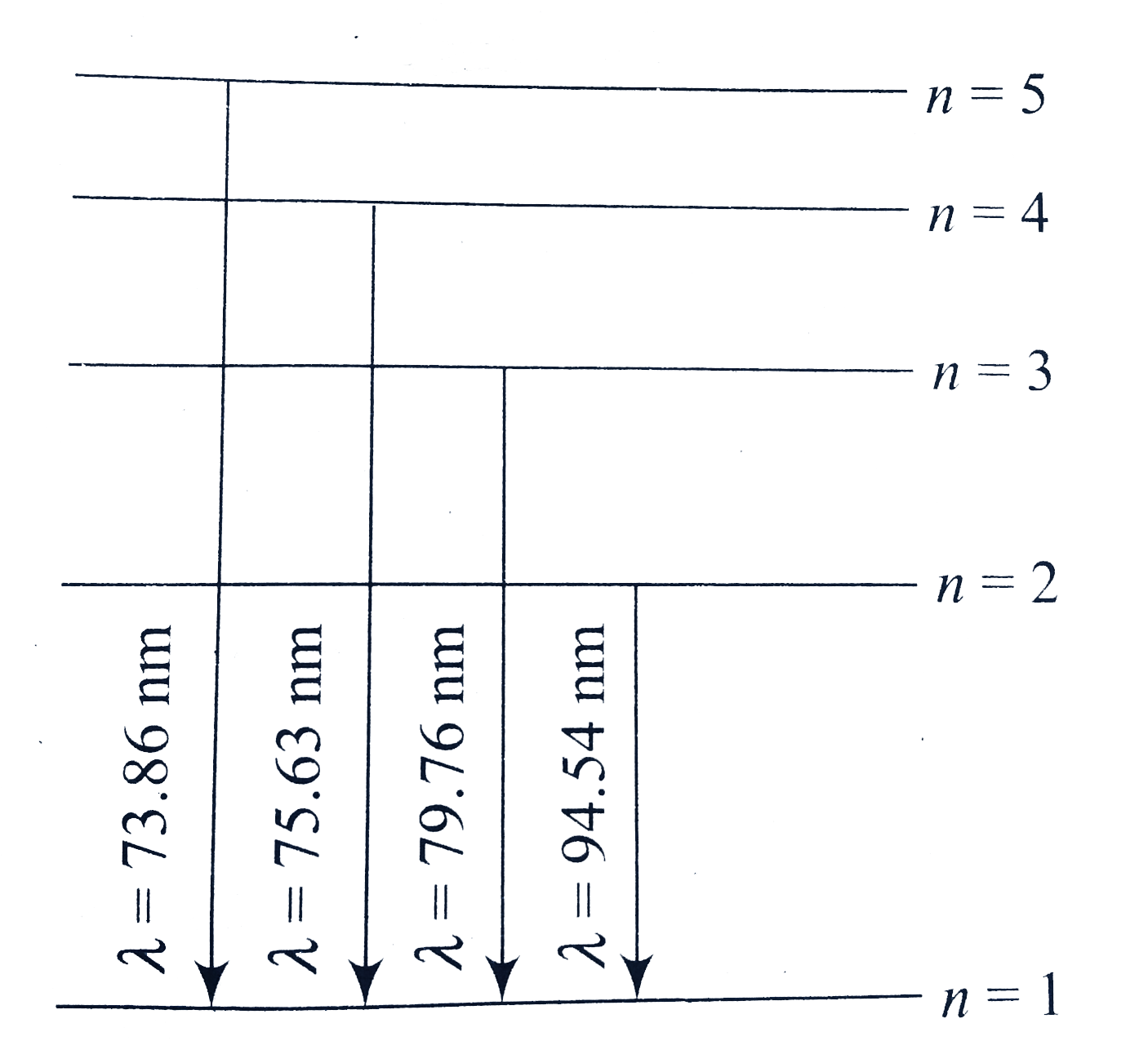
λ5→1=73.86nm
λ4→1=75.63nm
λ3→1=79.76nm
λ2→1=94.54nm
The possible energy of the atom in n=3 cannot beView SolutionQuestion 306
An electron in an H-atom kept at rest , jumps from the nth shell to the nth shell (m>n). Suppose instead of emitting electromagnetic wave, the energy reased is converted into the kinetic energy of the atom. Assume the Bohr model and convervation of angular momentum are valid. If l is the moment of inertia the angular valocity of the atom about the nucleus is 4(m−n)h/kl. Calculate k View SolutionQuestion 310
The electron in a hydrogen atom make a transtion n1→n2 where n1andn2 are the priocipal quantum number of the two states . Assume the Bohr model to be valid . The time period of the electron in the initial state is eight time that in the final state . The possible values of n1andn2 are View SolutionQuestion 326
Imagine an atom made up of a proton and a hypothetical particle of double the mass of the electron but having the same charge as the electron . Apply the Bohr atom model and consider all possible transitions of this hypothetical particle that will be emitted level . The longest wavelength photon that will be emitted has longest wavelength λ (given in terms of the Rydberg constant R for the hydrogen atom) equal to View SolutionQuestion 330
The intensity of X-rays form a Coolidge tube is plotted against wavelength λ as shown in the figure. The minimum wavelength found is λc and the wavelength of the Kα line is λk. As the accelerating voltage is increased
(a) λk−λc increases (b) λk−λc decreases
(c ) λk increases (d) λk decreases View SolutionQuestion 336
A photon collides with a stationary hydrogen atom in ground state inelastically . Energy of the colliding photon is 10.2eV. After a time interval of order of micro second another photon collides with same hydrogen atom inelastically with an energy of 15eV what will be observed by the detector? View SolutionQuestion 344
The electron in a hydrogen atom make a transition n1→n2 where n1andn2 are the principal quantum number of the two states . Assume the Bohr model to be valid . The time period of the electron in the initial state is eight time that in the final state . The possible values of n1andn2 are View SolutionQuestion 345
STATEMENT - 1
If the accelerating potential in an X - rays tube is increased, the wavelength of the characteristic X- rays do not change .
STATEMENT -2
When an electron beam strikes the target in an X- rays tube, part of the kinectic energy is converted into X - rays energy . View SolutionQuestion 346
In a mixture of H−He+ gas (He+is singly ionized He atom), H atom and He+ ions are excited to their respective first excited state. Subsequently H atoms transfer their total excitation energy to He+ ions (by collisions) Assume that the bohr model of atom is exactly valid.
The quantum number n of the state finally populated in He+ inos is - View SolutionQuestion 347
In a mixture of H−He+ gas (He+is singly ionized He atom), H atom and He+ ions are excited to their respective first excited state. Subsequently H atoms transfer their total excitation energy to He+ ions (by collisions) Assume that the bohr model of atom is exactly valid.
The wavelength of light emitted in the visible region by He+ lons after collisions with H atoms is - View SolutionQuestion 348
In a mixture of H−He+ gas (He+is singly ionized He atom), H atom and He+ ions are excited to their respective first excited state. Subsequently H atoms transfer their total excitation energy to He+ ions (by collisions) Assume that the bohr model of atom is exactly valid.
The ratio of the kinetic energy of the n=2 electron for the H atom to the of He+ lon is - View SolutionQuestion 349
The key feature of Bohr's spectrum of hydrogen atom is the quantization of angular momentum when an electron is revolving around a proton. We will extend this to a general rotational motion to find quantized rotational energy of a diatomic molecule assuming it to be rigid.The rule to be applied is Bohr's quantization condition.
A diatomic molecule has moment of inertia I. By Bohr's quantization condition its rotational energy in the nth level (n=0 is not allowed ) is View SolutionQuestion 350
The key feature of Bohr's spectrum of hydrogen atom is the quantization of angular momentum when an electron is revolving around a proton. We will extend this to a general rotational motion to find quantized rotational energy of a diatomic molecule assuming it to be rigid.The rule to be applied is Bohr's quantization condition.
it is found that the excitation from ground to the first excited state of rotation for the CO molecule is close to 4π×1011Hz then the moment of inertia of CO molecule about its center of mass is close to
(Takeh=2π×10−34Js)View SolutionQuestion 351
The key feature of Bohr's spectrum of hydrogen atom is the quantization of angular momentum when an electron is revolving around a proton. We will extend this to a general rotational motion to find quantized rotational energy of a diatomic molecule assuming it to be rigid.The rule to be applied is Bohr's quantization condition.
In a CO molecule, the distance between C(mass=12a.m.u)andO(mass=16a.m.u) where 1a.m.u=53×10−27kg,is close to View Solution

